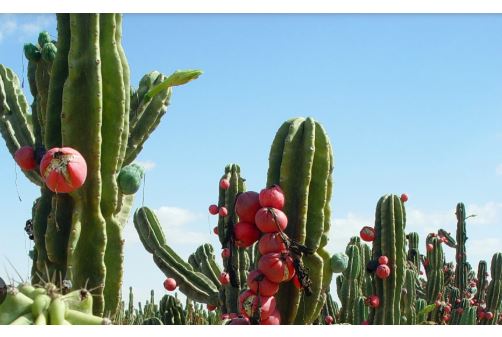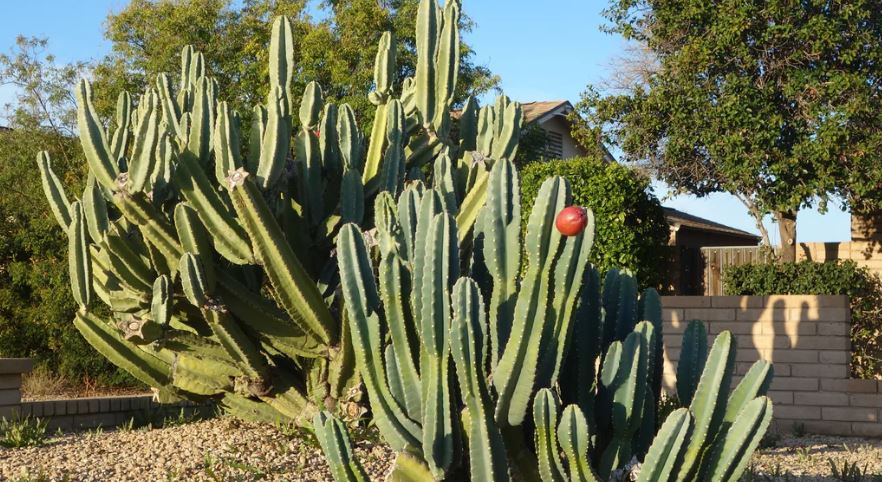
The Peruvian Apple Cactus, scientifically classified as Cereus repandus (syn. Cereus peruvianus), belongs to the Cactaceae family, specifically within the Cactoideae subfamily and Cereeae tribe. The genus Cereus, derived from the Latin word for “torch,” includes about 33 species of columnar cacti native to South America.
The species name repandus, meaning “turned up or back,” refers to the slightly wavy ribs of its stems. This perennial succulent, often confused with similar species like Cereus hildmannianus, is a distinct member of its genus, valued for both ornamental and culinary contributions, with a history of taxonomic reclassification reflecting its complex botanical identity.
Cereus repandus is a large, columnar cactus with a shrubby or tree-like form, typically growing 10–33 feet (3–10 meters) tall in the wild, though cultivated specimens may reach greater heights with support. Its cylindrical, gray-green to blue-green stems, 4–8 inches (10–20 cm) in diameter, feature 8–13 ribs lined with gray spines up to 2 inches (5 cm) long, though some stems are nearly spineless.
From late spring to early fall, it produces large, nocturnal, cream-colored to white flowers, 4–6 inches (10–15 cm) wide, with reddish tips, blooming for one night and emitting a subtle fragrance. These give way to edible, thornless fruits—called Peruvian apples or pitaya—spherical to egg-shaped, 1–2 inches (2.5–5 cm) long, with red, yellow, or violet-red skin and white, seed-filled flesh resembling dragon fruit in texture and mild sweetness.
Native to South America, Cereus repandus originates in arid and semi-arid regions of Brazil, Uruguay, Argentina, and Paraguay, thriving in diverse habitats from rocky hillsides to coastal plains. Unlike its misleading common name, it is not native to Peru, though it’s widely cultivated there and globally. It has naturalized in parts of Florida, Arizona, Southern California, the Caribbean, and Israel, where it’s grown commercially for fruit and ornamentation.
Its adaptability to hot, dry climates has led to widespread cultivation in Mediterranean and desert regions, though it’s not considered invasive. The cactus supports local wildlife, with its fruit sustaining birds and small mammals in its native range.
The Peruvian Apple Cactus is hardy in USDA zones 9a–11b, tolerating temperatures as low as 20°F (-6.7°C) for brief periods but thriving in warm, dry climates between 60°F and 85°F (15°C–29°C). It’s frost-sensitive, requiring protection or indoor cultivation in cooler zones below 9a, such as during winter in zones 7–8, where it can be grown in pots and moved to a greenhouse or bright window. In zones 9–11, it flourishes outdoors year-round, needing full sun and minimal water to mimic its arid origins, making it a staple in desert landscapes.
Cereus repandus is prized as an ornamental plant for its dramatic, upright form and striking nocturnal blooms, making it a focal point in xeriscapes, rock gardens, or succulent collections. Its towering stems create vertical accents in arid landscapes, serving as natural hedges, windbreaks, or property boundaries in zones 9–11.
In smaller gardens or patios, it thrives in large containers, adding sculptural beauty with its ribbed, spiny silhouette. The edible fruit, rich in vitamin C and fiber, offers culinary value, eaten fresh or used in jams, while its night-blooming flowers attract bats and moths, enhancing pollinator ecosystems. Caution is needed due to spines, but its low water needs and bold presence make it ideal for sustainable, desert-inspired designs.

How To Grow And Care For Peruvian Apple Cactus
Light Requirements
Provide full sun, with at least 6–8 hours of direct sunlight daily, to promote healthy growth and flowering. It thrives in bright, open conditions mimicking its arid origins. In partial shade, stems may elongate or weaken, so prioritize sunny spots outdoors or a south-facing window for indoor plants.
Soil Preferences
Use a well-draining cactus or succulent mix with a pH of 6.0–7.5, ideally combining 50% potting soil, 30% sand, and 20% perlite or gravel. Native to rocky soils, it tolerates poor fertility but requires excellent drainage to prevent root rot. In containers, ensure the mix remains loose and gritty.
Watering Needs
Water sparingly, about 1 inch (2.5 cm) every 2–3 weeks in spring–summer, allowing soil to dry completely between waterings. During fall–winter, reduce to once a month or less, as overwatering causes stem rot. Young plants need slightly more frequent watering (weekly) until established, but always check soil moisture first.
Temperature Range
Grow in USDA zones 9a–11b, where temperatures range from 20°F to 85°F (-6.7°C to 29°C). It tolerates brief cold snaps but suffers below 25°F (-4°C); protect with frost cloth in zones 9a–9b. In colder zones, cultivate in pots and move indoors during winter, keeping above 50°F (10°C).
Humidity Levels
Prefer low to moderate humidity (20–40%), suited to desert climates. High humidity increases fungal risks, so ensure good air circulation, especially in greenhouses or indoors. Avoid misting; dry air enhances stem health, though indoor plants may need occasional ventilation to prevent moisture buildup.
Container Selection
Choose deep, sturdy pots with drainage holes, at least 12–18 inches (30–45 cm) wide, to support its tall, heavy stems and deep roots. Terracotta or heavy plastic pots prevent tipping as it grows. Repot every 2–3 years to refresh soil, ensuring stability for its upright form.
Fertilization
Apply a low-nitrogen, cactus-specific fertilizer (e.g., 5-10-10 NPK) once in spring and again in midsummer to support growth and fruiting. Dilute liquid fertilizer to half-strength for potted plants. Avoid over-fertilizing, as excess nutrients cause soft, weak stems; skip feeding in fall–winter.
Pruning
Prune minimally to remove damaged, diseased, or overcrowded stems, using clean, sharp shears in spring. Cut at a 45-degree angle to minimize water pooling. Trim offsets (pups) for propagation or to control size, but preserve the natural columnar shape, as heavy pruning can stress the plant.
Propagation
Propagate via stem cuttings or seeds. Take 6–12-inch (15–30 cm) cuttings, let them callus for 7–10 days, and plant in a sandy mix; roots form in 4–8 weeks. Seeds, sown at 70–80°F (21–27°C), germinate in 2–4 weeks but are slower to mature. Cuttings are preferred for faster growth.
Pest Control
Monitor for pests like scale, mealybugs, or spider mites, which may hide along ribs or areoles. Inspect regularly, treating infestations with neem oil or insecticidal soap in early morning. Maintain dry conditions and avoid wounding stems to reduce pest risks, as healthy cacti resist better.
Repotting
Repot every 2–3 years in spring, or when the plant becomes root-bound or top-heavy. Gently remove, shake off old soil, and replant in a fresh cactus mix, keeping the stem base at soil level. Water lightly after repotting, providing shade for a week to ease stress, with ample drainage.
Flowering and Fruit Care
Encourage nocturnal blooms (late spring–fall) with warm nights (above 60°F/16°C) and consistent light. Flowers last one night, attracting bats or moths; hand-pollinate with a brush for fruit set if pollinators are scarce. Harvest ripe, colorful fruits (red or yellow) when soft, removing carefully to avoid spines.
Common Issues
Address overwatering (soft, discolored stems, rot) by improving drainage and reducing frequency. Underwatering (shriveled, thin stems) requires slight watering increases. Poor flowering may indicate insufficient light or cold; adjust sun exposure or protect from chills. Scale or fungal spots are mitigated with better airflow and dry conditions.